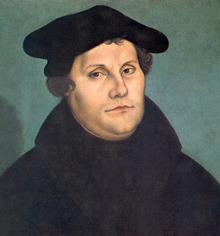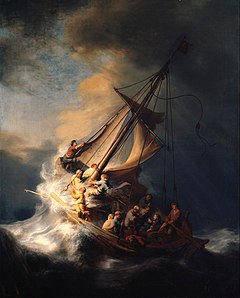Wär Gott nicht mit uns diese Zeit, BWV 14
| Wär Gott nicht mit uns diese Zeit | |
|---|---|
BWV 14 | |
| Chorale cantata by J. S. Bach | |
 Martin Luther, author of the hymn, in 1533 by Lucas Cranach the Elder | |
| Occasion | Fourth Sunday after Epiphany |
| Cantata text | anonymous |
| Chorale | by Martin Luther |
| Performed | 30 January 1735: Leipzig |
| Movements | 6 |
| Vocal |
|
| Instrumental |
|

Wär Gott nicht mit uns diese Zeit (Were God not with us at this time),[1] BWV 14,[a] is a church cantata by Johann Sebastian Bach. He composed the chorale cantata in Leipzig in 1735 for the fourth Sunday after Epiphany and first performed it on 30 January 1735. The text is based on the hymn by Martin Luther, published in 1524.
History and words
Bach composed the cantata in Leipzig for the fourth Sunday after Epiphany.[2] A fourth Sunday after Epiphany is rare and occurs only in years with a late date of Easter, and Bach had composed only one other cantata for this occasion, [[[Jesus schläft, was soll ich hoffen? BWV 81|Jesus schläft, was soll ich hoffen? BWV 81]]] Error: {{Lang}}: text has italic markup (help). In 1725, when Bach had composed his annual cycle of chorale cantatas, there was no fourth Sunday after Epiphany. In 1735, shortly after the first performance of his Christmas Oratorio, he seems to have desired to fill this void and complete his cycle of chorale cantatas. For Christoph Wolff it is evident that Bach performed the second cycle in 1735, performing the new cantata between [[[Was mein Gott will, das g'scheh allzeit, BWV 111|Was mein Gott will, das g'scheh allzeit, BWV 111]]] Error: {{Lang}}: text has italic markup (help), for the third Sunday after Epiphany and [[[Ich hab in Gottes Herz und Sinn, BWV 92|Ich hab in Gottes Herz und Sinn, BWV 92]]] Error: {{Lang}}: text has italic markup (help), for Septuagesima.[3]
The prescribed readings for the Sunday were taken from the Epistle to the Romans, "love completes the law" (Romans 13:8–10), and from the Gospel of Matthew, Jesus calming the storm (Matthew 8:23–27). The cantata text is based on the hymn in three stanzas by Martin Luther, a paraphrase of Psalm 124, published in Johann Walter's hymnal Eyn geystlich Gesangk Buchleyn of 1524.[4] According to John Eliot Gardiner, this hymn "apparently, had been sung on this Sunday in Leipzig from time immemorial".[5] The text of the first and the last stanza is kept unchanged; an unknown poet paraphrased the inner stanza to three movements, two arias framing a recitative.[2] According to Wolff, the poet may have been Andreas Stübel, writing in 1724/25.[3] The theme of the chorale is connected to the gospel in a general way: our life depends on God's help and is lost without it. A connection is also given by the image of flooding water that the psalm conveys, which begins "If it had not been the Lord who was on our side" (Psalms 124), and continues "then the waters had overwhelmed us, the stream had gone over our soul, then the proud waters had gone over our soul" (Psalms 124:4–5). The poet paraphrased it in the central recitative to "Es hätt uns ihre Wut wie eine wilde Flut und als beschäumte Wasser überschwemmet" ("Their fury would have, like a raging tide and like a foaming wave, flooded over us").[1]
Bach first performed the cantata on 30 January 1735. It is one of his latest extant church cantatas.[2]
Scoring and structure
The cantata in five movements is intimately scored for three vocal soloists (soprano, tenor, and bass), a four-part choir, corno da caccia, two oboes, two violins, viola, and basso continuo.[2]
- Chorus: Wär Gott nicht mit uns diese Zeit
- Aria (soprano): Unsre Stärke heißt zu schwach
- Recitative (tenor): Ja, hätt es Gott nur zugegeben
- Aria (bass): Gott, bei deinem starken Schützen
- Chorale: Gott Lob und Dank, der nicht zugab
Music
The chorale is sung to the tune of "Wo Gott der Herr nicht bei uns hält",[6] which Bach had treated to a chorale cantata, [[[Wo Gott der Herr nicht bei uns hält, BWV 178|Wo Gott der Herr nicht bei uns hält, BWV 178]]] Error: {{Lang}}: text has italic markup (help). The opening chorus is an unusual composition that does not follow the scheme of instrumental ritornellos with a cantus firmus line by line sung by the soprano in long notes. In a setting resembling a motet, the strings play colla parte with the voices, and each line of the chorale is prepared by a complex four-part counter-fugue, in which the first entrance of a theme is answered in its inversion. After preparing entrances, the chorale melody is not sung but played by the horn and the oboes in long notes, creating a five-part composition, which is unique in Bach's cantata movements. The only other piece of similar complexity, also giving the cantus firmus to the instruments, is the opening chorus of [[[Ein feste Burg ist unser Gott, BWV 80|Ein feste Burg ist unser Gott, BWV 80]]] Error: {{Lang}}: text has italic markup (help), but it is not conceived as a counter-fugue.[2]
In the first aria, the soprano is accompanied by the strings and the horn, which contrasts the text's "stark" (strong) and "schwach" (weak) in combination with the voice.[3] Gardiner notes that the horn supports the voice "in its highest register (referred to in the autograph part as Corne. par force and tromba)".[5] In the central recitative, the dangers of the flooding waters are illustrated in fast passages of the continuo on words such us "Wut" ("fury"), "Flut" ("flood") and "überschwemmet" ("inundate"), making it almost an arioso. Similar word painting occurs in the middle section of the bass aria, picturing "Wellen" (waves) in octave leaps and fast downward scales.[2] The closing chorale is a four-part setting with "contrapuntally animated bass and middle voices", similar to the chorales of the Christmas Oratorio, first performed a few weeks before. Wolff summarizes the maturity of Bach's late church cantatas caused by "the experience accumulated by the composer between 1723 and 1729, which lends the later cantatas an especial ripe character".[3]
Selected recordings
- J.S. Bach: Das Kantatenwerk – Sacred Cantatas Vol. 1, Gustav Leonhardt, Tölzer Knabenchor, King's College Choir, Leonhardt-Consort, soloist of the Tölzer Knabenchor, Marius van Altena, Max van Egmond, Teldec 1972
- Die Bach Kantate Vol. 8, Helmuth Rilling, Gächinger Kantorei, Württembergisches Kammerorchester Heilbronn, Krisztina Láki, Aldo Baldin, Philippe Huttenlocher, Hänssler 1984
- Bach Made in Germany Vol. 4 – Cantatas III, Hans-Joachim Rotzsch, Thomanerchor, Neues Bachisches Collegium Musicum, Monika Frimmer, Eberhard Büchner, Andreas Scheibner, Eterna 1984
- Bach Cantatas Vol. 19: Greenwich/Romsey, John Eliot Gardiner, Monteverdi Choir, English Baroque Soloists, Joanne Lunn, Paul Agnew, Peter Harvey, Soli Deo Gloria 2000
- Bach Edition Vol. 18 – Cantatas Vol. 9, Pieter Jan Leusink, Holland Boys Choir, Netherlands Bach Collegium, Ruth Holton, Knut Schoch, Bas Ramselaar, Brilliant Classics 2000
- J.S. Bach: Complete Cantatas Vol. 20, Ton Koopman, Amsterdam Baroque Orchestra & Choir, Johannette Zomer, James Gilchrist, Klaus Mertens, Antoine Marchand 2002
Notes
- ^ "BWV" is Bach-Werke-Verzeichnis, a thematic catalogue of Bach's works.
References
- ^ a b Dellal, Pamela. "BWV 14 – Wär Gott nicht mit uns diese Zeit". Emmanuel Music. Retrieved 19 January 2015.
- ^ a b c d e f Dürr, Alfred (1981). Die Kantaten von Johann Sebastian Bach (in German). Vol. 1 (4 ed.). Deutscher Taschenbuchverlag. pp. 199–202. ISBN 3-423-04080-7.
- ^ a b c d Wolff, Christoph (1995). The Cantatas of the Picander early 1730s (PDF). bach-cantatas.com. pp. 24–25. Retrieved 24 January 2012.
- ^ "Wär Gott nicht mit uns diese Zeit / Text and Translation of Chorale". bach-cantatas.com. 2006. Retrieved 23 January 2012.
- ^ a b Gardiner, John Eliot (2006). "Cantatas for the Fourth Sunday after Epiphany / Abbey Church of St Mary and St Ethelflaeda, Romsey" (PDF). bach-cantatas.com. p. 8. Retrieved 24 January 2012.
- ^ "Chorale Melodies used in Bach's Vocal Works / Wo Gott der Herr nicht bei uns hält". bach-cantatas.com. 2009. Retrieved 17 January 2012.
Sources
- Free scores by Wär Gott nicht mit uns diese Zeit, BWV 14 at the International Music Score Library Project (IMSLP)
- Wär Gott nicht mit uns diese Zeit BWV 14; BC A 40 / Chorale cantata Leipzig University
- Cantata BWV 14 Wär Gott nicht mit uns diese Zeit: history, scoring, sources for text and music, translations to various languages, discography, discussion, bach-cantatas website
- Wär Gott nicht mit uns diese Zeit: history, scoring, Bach website Template:De icon
- BWV 14 Wär Gott nicht mit uns diese Zeit: English translation, University of Vermont
- BWV 14 Wär Gott nicht mit uns diese Zeit: text, scoring, University of Alberta
- Chapter 61 BWV 14 Wär Gott nicht mit uns diese Zeit / Were God not to be with us now. Julian Mincham, 2010
